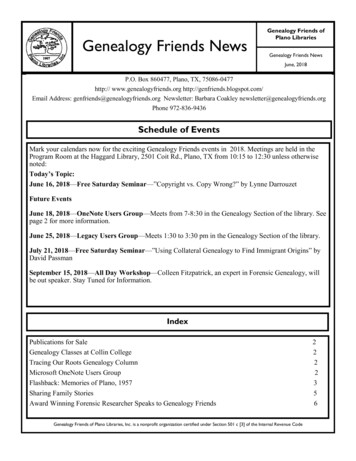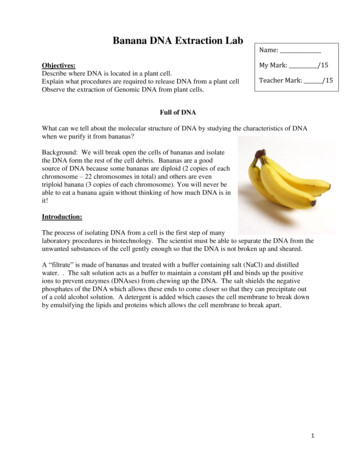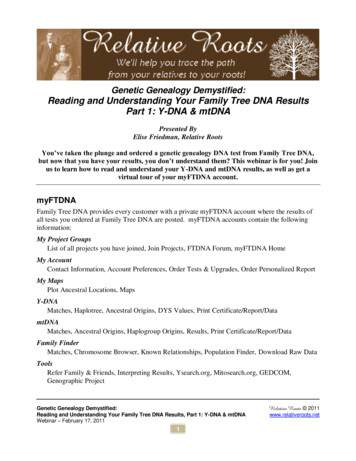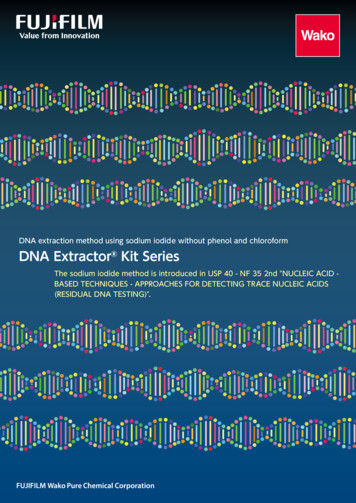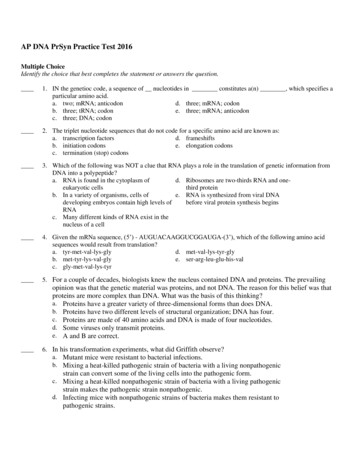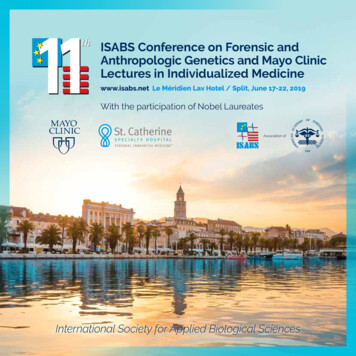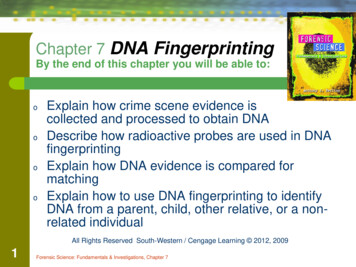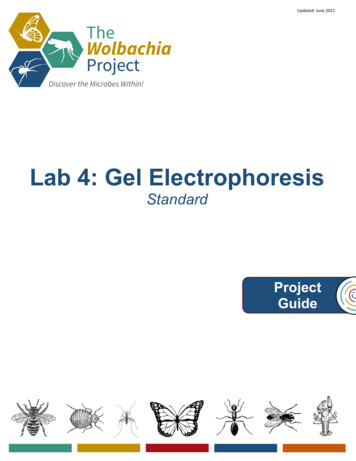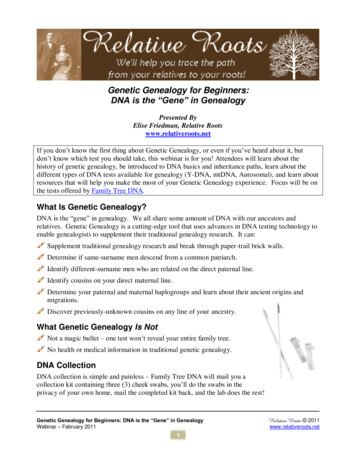
Transcription
Genetic Genealogy for Beginners:DNA is the “Gene” in GenealogyPresented ByElise Friedman, Relative Rootswww.relativeroots.netIf you don’t know the first thing about Genetic Genealogy, or even if you’ve heard about it, butdon’t know which test you should take, this webinar is for you! Attendees will learn about thehistory of genetic genealogy, be introduced to DNA basics and inheritance paths, learn about thedifferent types of DNA tests available for genealogy (Y-DNA, mtDNA, Autosomal), and learn aboutresources that will help you make the most of your Genetic Genealogy experience. Focus will be onthe tests offered by Family Tree DNA.What Is Genetic Genealogy?DNA is the “gene” in genealogy. We all share some amount of DNA with our ancestors andrelatives. Genetic Genealogy is a cutting-edge tool that uses advances in DNA testing technology toenable genealogists to supplement their traditional genealogy research. It can:Supplement traditional genealogy research and break through paper-trail brick walls.Determine if same-surname men descend from a common patriarch.Identify different-surname men who are related on the direct paternal line.Identify cousins on your direct maternal line.Determine your paternal and maternal haplogroups and learn about their ancient origins andmigrations.Discover previously-unknown cousins on any line of your ancestry.What Genetic Genealogy Is NotNot a magic bullet – one test won’t reveal your entire family tree.No health or medical information in traditional genetic genealogy.DNA CollectionDNA collection is simple and painless – Family Tree DNA will mail you acollection kit containing three (3) cheek swabs, you’ll do the swabs in theprivacy of your own home, mail the completed kit back, and the lab does the rest!Genetic Genealogy for Beginners: DNA is the “Gene” in GenealogyWebinar – February 20111Relative Roots 2011www.relativeroots.net
How Genetic Genealogy Began1997: Geneticists Michael Hammer and Karl Skorecki used DNA testing to determine if Jewish menwith a tradition of Cohen ancestry (Jewish priests – direct patrilineal descendants from Aaron)shared a common Y chromosome signature.1999: Entrepreneur and genealogist Bennett Greenspan contacted Michael Hammer to inquire aboutusing Y chromosome testing for genealogy – if it worked for the Jewish priests, why not others!April 2000: After many discussions, a business plan, a proof of concept and more Family TreeDNA was launched as the first commercial provider of DNA testing for genealogy.DNA BasicsEvery cell in our body contains DNA. Our DNA consists of:46 chromosomes (23 pair)22 pair autosomal chromosomes, or autosomes1 pair sex chromosomes (X,Y)Mitochondrial DNA (mtDNA)DNA is made upof 4 bases:AdenineCytosineThymineGuanineDNA Inheritance BasicsWe each inherit approximately 50% of our DNA from each parent.Some of our DNA is passed down from our mother or father completely in-tact, while other parts ofour DNA are a combination of each parents’ DNA.Y chromosome: Inherited by men only, via their direct paternal line (father’s father’s father, etc)X chromosome: Men inherit one from their mother only; women inherit one from each parent.Mitochondrial DNA: Inherited by both men and women, via their direct maternal line (mother’smother’s mother, etc)Autosomes: Both men and women inherit one of each of the 22 pair of autosomes from each parent.Genetic Genealogy for Beginners: DNA is the “Gene” in GenealogyWebinar – February 20112Relative Roots 2011www.relativeroots.net
Types of Genealogy TestsThere are three (3) major types of DNA tests commonly offered for genealogy:Y ChromosomeMitochondrial DNAAutosomal DNAY Chromosome (Y-DNA)Y-DNA testing focuses on the direct paternal line – ie, the father’s father’s father, etc. Only mencan take this test; women do not have a Y chromosome. However, women can ask a male relativewho represents the surname line that she’s interested in to take a Y-DNA test.Highlights of Y-DNA testing:Most often used for determining whether men with the same surname descend from a commonpatriarch. In support of this goal, major genetic genealogy companies host surname projects thatare run by volunteers interested in the genealogy of a particular surname.Can also identify a direct paternal connection between men with different surnames. Very usefulfor adoptees, people from populations that haven’t had inherited surnames for more than acouple hundred years, and families whose biological paternal line has a break in the surnameinheritance due to adoption, deliberate surname changes, misattributed paternity, etc.Can suggest geographic and deep ancestral origins, such as Native American, Cohanim, WesternEuropean or African origins – all on the direct paternal line.Reported as a series of Y chromosome marker values (alleles), which are compared against othercustomers’ results to determine if there’s a match.Sample Raw Results:Family Tree DNA will compare your “alleles” with the results of other customers in the Family TreeDNA database and provide you with a list of names and email addresses of your matches. You canthen contact your matches and compare your family trees!How Many Markers?Family Tree DNA offers 12, 25, 37 and 67-marker tests.The more markers tested and compared, the more confident you can be that your match isrecently related. At least 37 markers are best for genealogical purposes.o An exact 12-marker match gives a 90% chance of two people sharing a commonancestor within 1 to 23 generations,o An exact 37-marker match gives a 90% chance of two people sharing a commonancestor within 1 to 5 generations.Genetic Genealogy for Beginners: DNA is the “Gene” in GenealogyWebinar – February 20113Relative Roots 2011www.relativeroots.net
Mitochondrial DNA (mtDNA)mtDNA testing focuses on the direct maternal line – ie, a mother’s mother’s mother, etc. Both menand women can take this test and be compared to each other.Highlights of mtDNA testing:Verify if two people are related via a direct maternal line.Can suggest geographic and deep ancestral origins, such as Native American, Western Europeanand African origins – all on the direct maternal line.Reported as differences from the Cambridge Reference Sequence (CRS), which are comparedagainst other customers to determine if there’s a match.Sample Raw Results:HVR1 Hyper Variable Region 1HVR2 Hyper Variable Region 2CR Coding Region (everything except HVR1 and HVR2)Which Test Level?Family Tree DNA offers three (3) mtDNA tests:o mtDNA (Basic) – HVR1o mtDNAPlus – HVR1 and HVR2omtFullSequence – Entire mtDNA (HVR1, HVR2, CR)The higher the level you test and match someone on, the more confident you can be that yourmatch is recently related:o An exact match on mtDNA (Basic) gives a 50% chance of sharing a common ancestorwithin 52 generationso An exact match on mtDNAPlus gives a 50% chance of sharing a common ancestor within28 generations.o An exact match on mtFullSequence gives a 50% chance of sharing a common ancestorwithin 5 generations.Genetic Genealogy for Beginners: DNA is the “Gene” in GenealogyWebinar – February 20114Relative Roots 2011www.relativeroots.net
Autosomal DNA (Family Finder)Autosomal testing extends the power of genetic genealogy to all ancestral lines rather than only adirect paternal or direct maternal line. Both men and women can take this test and be compared toeach other.Highlights of Autosomal testing:Discover connections to descendants of your sixteen (16) great-grandparents.Determine degree of relationship with matchesGreat test for adoptees to discover their ancestry and clues to their birth parents’ familiesIncludes Population Finder, which determines the percentages of different ancestries thatcomprise your genetics.Family Finder ToolsMatches: Provides match name, email address, suggested relationship, relationship range, lengthof matching DNA segments, ability to assign relationships for known relatives, ancestralsurnames (if provided by match), gedcom (if provided by match), notes page to record info aboutthe match.Chromosome Browser: Graphical view of matching segmentsPopulation Finder: Percentages of different ancestries that comprise your genetics.Download Raw DataGenetic Genealogy for Beginners: DNA is the “Gene” in GenealogyWebinar – February 20115Relative Roots 2011www.relativeroots.net
Making the Most of Your Genetic Genealogy ExperienceReceiving, reading and understanding your results shouldn’t be the end of your genetic genealogyjourney. Here are some ways you can make the most of this experience:Share. Your myFTDNA account has fields to enter your Most Distant Known Ancestor’s(MDKA) name and location, as well as all the surnames in your ancestry. You can alsoupload a GEDCOM of your family tree. Entering all this information will enable yourmatches to learn something about your genealogy before they even contact you.Communicate. Don’t be afraid to email your matches, and definitely respond to emails thatyou receive from your matches! All customers can choose whether to sign the green releaseform that Family Tree DNA provided with your swab kit, which gives FTDNA permission toprovide their name and email address to matches. So everyone who you see on your Matchespage has signed this form and given permission.Participate. Family Tree DNA has over 6,000 different projects which focus on surname,geography, heritage or haplogroups. Projects are all run by volunteer administrators and arefree to join. Joining projects is the best way to stay informed about news related to the topicof the project, and you have the added benefit of getting support and assistance from yourproject administrator. Also, Y-DNA tests ordered through a project are always discountedfrom Family Tree DNA’s retail prices.Be Proactive. No project for your surname yet? Start one and recruit other people with yoursurname to get tested. You don’t have to be an expert on genetic genealogy to start a project.Learn. Keep learning about genetic genealogy by attending Relative Roots Webinars,visiting the International Society of Genetic Genealogy website, and joining discussionforums and email lists that discuss genetic genealogy. Project administrators are also invitedonce a year to attend a conference hosted by Family Tree DNA in Houston.Test More. Upgrading existing tests, ordering new types of tests, and/or testing other familymembers all have the potential to enhance your Genetic Genealogy experience. Higher leveltests refine results, each type of test has a different purpose, and testing other familymembers may help you target a specific ancestor that your own results do not.Genetic Genealogy for Beginners: DNA is the “Gene” in GenealogyWebinar – February 20116Relative Roots 2011www.relativeroots.net
WebsitesRelative Rootso http://www.relativeroots.neto http://www.relativeroots.net/webinars/o http://www.relativeroots.net/blog/o http://www.facebook.com/RelativeRootso http://www.twitter.com/RelativeRootsFamily Tree DNAo http://www.familytreedna.com/o http://www.familytreedna.com/faq/o http://www.facebook.com/FamilyTreeDNAInternational Society of Genetic Genealogy (ISOGG) – it’s free to join!o http://www.isogg.orgGenetic genealogy mailing lists and discussion forums:o http://forums.familytreedna.como http://www.yahoogroups.com/group/ISOGGo http://www.yahoogroups.com/group/DNA-Newbieo http://www.dna-forums.orgo http://lyris.jewishgen.org/ListManager (JewishGen)o /GENEALOGY-DNA.htmlThank you for attending aRelative Roots webinar!Please visit our website often to learn about additional webinars and/or join the Relative RootsWebinars Announcements email list at http://www.relativeroots.net/webinars/Follow Relative Roots on Facebook and com/RelativeRootsGenetic Genealogy for Beginners: DNA is the “Gene” in GenealogyWebinar – February 20117Relative Roots 2011www.relativeroots.net
Genetic Genealogy for Beginners: DNA is the "Gene" in Genealogy Relative Roots 2011 Webinar - February 2011 www.relativeroots.net 1
